Chapter 9. Kodiak Archipelago
Day 58 - July 12 - Kodiak Archipelago
(Shari) Bert is hanging the VBS banner across the side of R-TENT-III when
Steve and Nancy pull up alongside us. We are parking our RVís at the Faith
Lutheran Church while we go to Kodiak for our side trip. The church is
sponsoring a Vacation Bible School while we are gone and has asked if we would
mind being a fence post for their advertising banner. Of course we do not mind.
After we park four other RVís, we drive to the ferry dock, get our tickets and
board the M/V Tustumena for our 14 hr. trip.
(Bert) Five of our rigs are parked parallel in the lot of the Lutheran church
at Homer where Shari and I attended worship last Sunday. Ours is closest to the
busy highway and the D.C.E. at the church helps me attach a big banner across
the RV announcing their Vacation Bible School coming this next week. We leave
our rigs and head to the dock at the end of the spit, there meeting up with
others of our group, a total of 16 headed to Kodiak Island this morning.
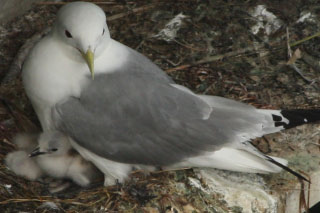 As walk-ons, our group is the first to board the M/V Tustumena, an old ship
as denoted on the big brass bell at the bow with the date 1964. Built in
Wisconsin and refurbished on the West Coast, everything about the exterior feels
heavy and large and hard, softened only slightly by the thick layers of white
and black paint. Inside, the walkways are narrow, especially with both my arms
struggling with luggage. We dump all our bags on the seats of a table booth and
head outside. While we wait for cars and trucks to be loaded and lowered below
deck with a 2-vehicle elevator, we stand at the bow watching gulls on the dock.
Just below the pier, resting on a narrow shelf of support beams are Black-legged
Kittiwakes sitting on nests. At first I thought they were on eggs, but when two
of them rise slightly I see tiny fuzzy chicks beneath them. One chick is
obviously hungry and peeps persistently, pointing its tiny bill toward its
mother. The adult obliges and regurgitates a slimy mass of food between its open
mandibles and from which the chick pecks a tiny piece.
As walk-ons, our group is the first to board the M/V Tustumena, an old ship
as denoted on the big brass bell at the bow with the date 1964. Built in
Wisconsin and refurbished on the West Coast, everything about the exterior feels
heavy and large and hard, softened only slightly by the thick layers of white
and black paint. Inside, the walkways are narrow, especially with both my arms
struggling with luggage. We dump all our bags on the seats of a table booth and
head outside. While we wait for cars and trucks to be loaded and lowered below
deck with a 2-vehicle elevator, we stand at the bow watching gulls on the dock.
Just below the pier, resting on a narrow shelf of support beams are Black-legged
Kittiwakes sitting on nests. At first I thought they were on eggs, but when two
of them rise slightly I see tiny fuzzy chicks beneath them. One chick is
obviously hungry and peeps persistently, pointing its tiny bill toward its
mother. The adult obliges and regurgitates a slimy mass of food between its open
mandibles and from which the chick pecks a tiny piece.
(Shari) After piling our luggage on a table, most of the group heads outside
to the bow of the boat. Here they stay for almost the entire trip, enduring wind
and drizzle and cold just not to miss a bird. I periodically go outdoors and
watch whales spout but mostly stay inside. We have a relatively good sailing day
without whitecaps. Nevertheless the swells make the boat roll and Marie gets a
bit sick.
(Bert) Loading the many vehicles must take longer than usual and we leave
Homer Spit an hour late. Through Kachemak Bay we see most of the same birds
weíve watched other trips, including a few flocks of Red-necked Phalaropes which
seem an oddity for the open sea. After we pass Seldovia, Iím in waters I havenít
traveled before. We find good numbers of Northern Fulmars, both light and dark
forms. The Tustumena rounds the last cliffs of the Kenai Peninsula at the
opening of Cook Inlet and the temperature drops a few more degrees. Although
this is mid July, we are wearing only one layer less clothes than we did in
Nome, i.e., three below the belt and four above. Hoods are up and securely tied
over our heads; gloves are kept on our hands. Fortunately the seas are calm and
the wind light or Iíd have to add another layer from the clothes packed in my
duffle bag. Iíve been anxious to see shearwaters and now they appear. Back at
the dock I had handed out a comparison sheet on Sooty vs. Short-tailed
Shearwater and now we are put to the test of distinguishing the two look-alikes.
Fortunately we have the additional aid of an Alaska Marine Highway naturalist on
board and he tells us the first ones we are seeing are Short-tailed Shearwaters.
Since plumage details are hard to see on these fast moving birds, we learn how
to identify them by their erratic flight style. When we later also see Sooty
Shearwaters we can tell the difference in the flapping and gliding style, as
well as the darker shade of gray and the occasional showing of the whiter
underwings. We also find a few Parakeet Auklets and Marbled Murrelets, a neat
sighting but a tiny performance compared to the Humpback Whales and other
mammals.
The two Harbor Porpoises sedately arch through the water, while the ten or so
Dallís Porpoises splash exuberantly when they break the surface. I count at
least eight Humpback Whales, usually seen singly and we get many views of them
blowing and fluking. The most spectacular performance, however, is of one that
must be showing off to attract a mate. With its head well below the surface, it
draws its tail high above the water and vigorously slaps the surface, rigorously
thumping the water and splashing explosively. Then it turns on its side and
strikes its lateral fin against the surface: bam, bam, bam! The show goes on for
several minutes, alternating between tail pounding and fin slapping. A half hour
later another Humpback is just ahead of the ship, probably not more than 150 ft.
away. Much quicker than I can shift my camera in its direction, the whale is
airborne, shooting straight up out of the water, its immense body now vertical
with head to the sky and tail just clearing the surface, a full-length view. It
comes crashing to the surface just before the bow.
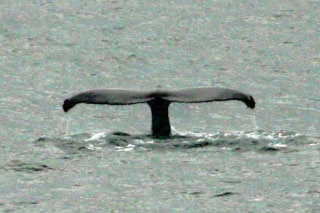
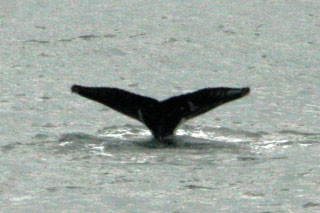
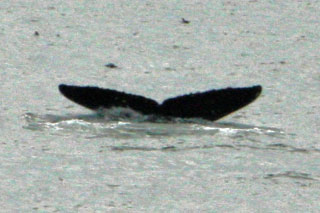
(Shari) The crew has a safety drill that does not instill confidence in me.
As I watch each crew member seems to have an area of the ship to search, locate
and count people. The dining room manager seems to be the trainer and has the
crew gather close to the table I occupy. I hear the whole procedure. As the crew
members gather they indicate what area they counted and the number of people
they saw. Another person adds them up. Oh my, they come up short. The captain
asks how many are accounted for and they answer 78. The captain says, ďThere are
152 passengers to account for. You had better go back and recount.Ē Off they go
and the second tally is not much more but they continue with the training. One
of the deckhands is training to be the leader and the procedure requires he use
exact and specific words when he addresses the captain. However, he has not
memorized the words and has to be reminded of each and every sentence. The
current leader tells him he should bring his cheat sheet to the next drill until
he learns the words. Then he tells the trainee he did a fine job. I THINK NOT! I
wonder how fast a ship sinks because this is taking a very long time. The crew
then stands around for orders and waits forever. Apparently someone has had a
fake heart attack and a fake helicopter is called to take him to the mainland.
After about 45 min. the drill is over and I, for one, am glad it was not for
real.
(Bert) A movie showing in the foredeck draws us inside at 3 PM. Excellent
footage of Grizzly Bears whets our appetite for seeing the Kodiak Bears, the
larger forms of these brown bears. I fall asleep part way through the next film
on the Aleuts and the despicable way they were treated during World War II. When
I awake I head outside again and am the only one on the foredeck. The ship
passes island mountains along the Aleutian chain: mountains with steep rock
cliffs, surrounded by spruce forests and capped with intensely green tundra that
from a distance looks like miles of golf courses. Tufted Puffins and Northern
Fulmars are common and then I see a much smaller bird with a different flight
style. Itís a Fork-tailed Storm-Petrel. When I see another I motion through the
window to the others. I see another and then I walk inside to tell others what I
am seeing. That gets Johnís attention and others follow later. In all I see
about six of the storm-petrels before we leave their nesting area at the Barren
Islands, but Iím afraid most of the group did not get out early enough to see
these special birds.
John spots a Pomarine Jaeger, the only jaeger of the day. We puzzle over some
juvenile gulls and especially wonder about the light bills on some of them, yet
decide that each gull is a young Black-legged Kittiwake, as are the thousands of
adults we have already seen today. It isnít until the ship nears Kodiak Island
that we see our first Pigeon Guillemots. We reach the dock at 8 PM and I see my
first bird on the island, a disappointing flock of Rock Pigeons. Is there
nowhere that has escaped their presence?
Day 59 - July 13 - Kodiak Island
(Bert) An early morning walk takes us across the high bridge at the port to
Near Island where we hike through a dense Sitka Spruce rainforest. Compared to
White Spruce, these trees are enormous with thick 5-ft. diameter trunks and
sharply broken lower limps that stick out like stout javelins. I hear
high-pitched squeaks from atop the spruce and suspect Blackpolls or
Golden-crowned Kinglets. They are so high in the dense canopy that most of us
cannot find them, but Jim sees one clearly and confirms they are the kinglets,
the first sighting of our Alaska trip. We return to the hotel in time for a
generously supplied Continental Breakfast that includes eggs and sausages. Then
Steve, Shari and I head to the rental agency to pick up our van and car for this
morningís island driving. We head out to the east and then north of Kodiak,
stopping at Potatopatch Lake for eclipsed plumage Mallard drakes, at Mission
Lake for American Wigeons Ė also in their dull eclipsed plumage Ė and see
several of the very dark forms of Song Sparrows. A look at the rocky coastline
and black lava sands at Mill Bay Beach gives us flocks of Harlequin Ducks, 14
Pigeon Guillemots and many Pelagic Cormorants. We continue touring along the
coastline and in view of the vibrantly green mountainsides until the road ends
at White Sands Beach, also black sand with a just enough of a swish of white
sands mixed in to give it name. Salmon fishermen in hip boots try their luck
along the winding stream through marshlands. Steve and Nancy lead in a search
for yet another geocache and even get a few new recruits among our group. On the
return trip we stop briefly at a lookout point at Fort Abercrombie before
getting back to Kodiak for lunch.
As enjoyable as the morning has been, it pales in comparison to this
afternoon. We head to the end of Near Island where three float planes will take
us for bear watching at Kodiak Island National Wildlife Refuge.
(Shari) Flying in slow motion we lift off the water in our 6-passenger float
plane. All of us are soooo very excited. We have been given hip boots to wear
since we will land on a lake and have to hop out of the plane in knee deep
water. I think everyone took 50 pictures before we even left the dock. We model
our get up for the camera in different poses. Bert and I split up and his plane
takes off first. I tell Bent that I do NOT want the front seat and he gladly
snaps it up. Our pilot helps Marie and Donna and me up the narrow metal bracket
steps. I hope no one takes movies of us getting in since I do not think it is a
pretty picture. Finally we get on our seat belts and off we go.
(Bert) Comically fitted with waist-high rubber waders we snap photos of each
other modeling our new footwear. Perhaps we wonít need them if good weather
holds out, the high boots are meant for us to step out of the plane into water
and then hike through wet grass toward the bear viewing area. We are also
prepared with raincoats should the weather turn wet, a likely occurrence in the
Aleutian chain. We board our planes, with six people snuggly fitting into the
small compartment of each of two planes and seven in the third plane.
(Shari) The takeoff is so smooth that the only way I know we are airborne is
when I see the lake below me. Wearing headphones we can talk to each other and
the pilot and block out the engine noise. I am surprised that no one talks,
especially Jim who is never at a loss for words. I know why I am not taking; I
am praying. We travel about 120 mph and our destination is 45 min. away. I keep
looking at my watch. The ride is eerie-like, as we are moving but not moving.
120 miles per hour is slow motion. We seem to inch over the tops of the
mountains that have patches of snow. We seem to fly too close to lush green
hillsides. I wonder if Dean, our pilot, knows at every single minute where he
could land in case of an emergency. Sometimes I do not see water and I know we
have no wheels. In many places ahead and above us, it looks foggy. Dean tells us
we will go along the east side of the island and return on the west side. The
east side is the rainy one and gets more fog.
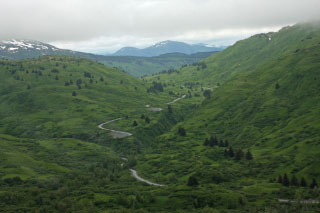 (Bert) I take the co-pilots seat, although I will contribute nothing toward
the flight controls. Taking off from the water our lift-off is smooth as silk
and soon we are looking down at the seacoast from a gullís viewpoint. Throughout
the 45-min. ride our pilot Josh keeps the plane close to the ground, lifting
over the mountain tops and dropping low over the valleys, lakes and streams.
Rising over one mountain we look down to see a flock of 47 Dallís Sheep scatter
from the noise of the plane. Inside the plane it is quiet since we each wear
headsets that allow us to communicate among ourselves and the pilot. He tells us
we are headed to Frazier Lake and as we approach we can see Dog Salmon River
pouring from the lake. Josh severely tilts the wings and we look down at the
river and can see a couple of fishing Kodiak Bears midstream.
(Bert) I take the co-pilots seat, although I will contribute nothing toward
the flight controls. Taking off from the water our lift-off is smooth as silk
and soon we are looking down at the seacoast from a gullís viewpoint. Throughout
the 45-min. ride our pilot Josh keeps the plane close to the ground, lifting
over the mountain tops and dropping low over the valleys, lakes and streams.
Rising over one mountain we look down to see a flock of 47 Dallís Sheep scatter
from the noise of the plane. Inside the plane it is quiet since we each wear
headsets that allow us to communicate among ourselves and the pilot. He tells us
we are headed to Frazier Lake and as we approach we can see Dog Salmon River
pouring from the lake. Josh severely tilts the wings and we look down at the
river and can see a couple of fishing Kodiak Bears midstream.
(Shari) We see Grizzly Bears below us that seem to be afraid of the plane
since they run like mad up the hillsides. The ones feeding at a falls are not
bothered by us. We come in for a landing, ever closer and closer to the water. I
never feel the plane make contact: one second we are still airborne and the next
on water. Dean motors to shore, hops into the water, grabs a rope and turns the
plane so it can be backed to the beach. He tethers the plane and helps us out
again. This time we step into 2 ft. of water and walk about 10 ft. until
reaching shore. The other two planes have already landed and have headed down
the 20 min. path to the bears. Along the walk we see lots and I mean lots of
bear scat. I hope we donít encounter a bear here, but am reassured to know that
Dean and the other two pilots are carrying a rifle.
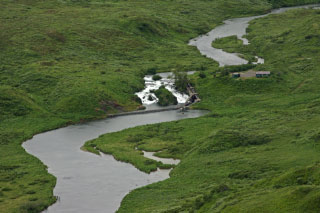 (Bert) Our landing on Frazier Lake is so smooth we do not know we have
touched water until we look out of the side windows to see splashing runners.
The land is dry so we can remove our boots and put on our tennis shoes. We head
off along the trail through fields of Wild Geranium and Coastal Paintbrush. No
trees are in this valley except for a few shrub sized willows from which
Golden-crowned Sparrows and Wilsonís Warblers sing. I wish there were more of
the Tree Swallows overhead to capture the hundreds of insects buzzing around our
heads, fortunately not biting though. Three-quarters mile along the trail we can
see Dog Salmon River and my first glimpse of a Kodiak Bear.
(Bert) Our landing on Frazier Lake is so smooth we do not know we have
touched water until we look out of the side windows to see splashing runners.
The land is dry so we can remove our boots and put on our tennis shoes. We head
off along the trail through fields of Wild Geranium and Coastal Paintbrush. No
trees are in this valley except for a few shrub sized willows from which
Golden-crowned Sparrows and Wilsonís Warblers sing. I wish there were more of
the Tree Swallows overhead to capture the hundreds of insects buzzing around our
heads, fortunately not biting though. Three-quarters mile along the trail we can
see Dog Salmon River and my first glimpse of a Kodiak Bear.
(Shari) The bear viewing area is just a grassy knoll alongside of a waterfall
and a manmade fish ladder. Before the fish ladder was built the falls were too
high for salmon to negotiate. The lake above the falls was stocked, the ladder
was built and now salmon return to the lake every year. Because the salmon
return, the bear come to eat. And we are not disappointed today. We see a total
of seven different adult bears. Two bears cross only 40 ft. in front of us, one
standing on its hind legs when he gets our scent. Our pilots seem unconcerned so
I continue to snap pictures.
(Bert) The river widens into a small pool below the fish ladder and on a
hillside we find soft seating amongst the lush green grass, a perfect vantage
point for surveying the pool and winding river. The first bear is along the left
edge of the pool, another is sleeping on a lofty knoll above the fish ladder and
a mother bear tends three spring cubs. The cubs are the smallest Iíve seen, born
this spring or maybe already in January in the den, they still have the light
blond fur collars offsetting the darker brown shade of their cuddly round
bodies. Thus the stage is set for the next few hours of absolutely delightful
entertainment highlighted by the antics of the cubs, the salmon fishing
determination of Mother Bear, and the peripheral participation of a cast of
seven other adult bears who attempt to fish along the edges of a territory
claimed by a highly protective Mother Bear. Also in the cast of characters is
Silver Fox Ė a form of Red Fox that has black hair tipped with silver Ė and up
to nine Bald Eagles perched variously across the marshy floodplain.
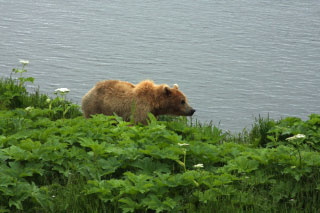
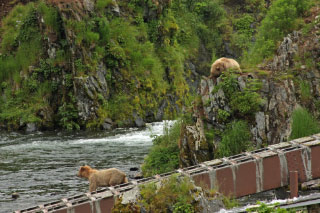
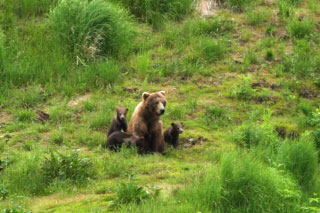
(Shari) By far the best show is put on by a momma and her three newborn cubs.
Those cubs follow her wherever she goes. I start to call one Ethan, like my
grandson. That cub is just everywhere he should not be. He is climbing over the
walls and looking over the edge so many times that I am sure he is going to fall
into the water. The cubs bark when momma is not giving them anything to eat. But
momma has to feed herself and she catches and eats three salmon while we watch.
Finally she is satiated and goes over to the hill, lies on her back and nurses
those babies. What a cute sight!
(Bert) The cubs steal the show, lumbering up one side of the fish dam,
scampering along the boardwalk, maintaining close contact with mother and even
reaching down with a paw to gently touch her head as she surveys the salmon
below the surface. One of the cubs complains squeakily and Mother sticks her
nose to her cubs, reassuring them of her attentive presence. Three or four times
she captures a salmon so quickly I do not see how she does it. Each time she
brings it to the surface in her jaws and lumbers off to the pool edge and up the
steep slope to a grassy spot, there to devour the bright red flesh in big gulps.
She shares none of the bounty with her cubs, they still nursing and too young to
feed on the chunks of salmon. Nonetheless they watch intently and sometimes get
too close to the action and are brushed aside. No sooner is one meal completed
when Mother Bear heads back to the water with her troop of cubs bouncing at her
heels.
Several times another adult bear comes within sight of Mother Bear, stopping
a good expanse away and plopping down in the grass to watch. As long as it keeps
its distance, the visiting bear is safe, but when Mother Bear moves in its
direction the other adult backs off. In one scene when Mother is carrying off
her salmon catch she takes offense of the intrusion and the adult, equally her
size, dashes off and out of sight.
Finally Mother Bear is satiated with salmon and the impatient cubs are ready
for dinner. Together they climb up the raw hillside to a grassy slope and Mother
Bear stretches out on her back. The cubs quickly are at her teats, each dining
vigorously on her milk. Occasionally a cub looks up at Mother and with loving
eyes and a wet nose she caresses the cub. In a lifetime of watching nature and
wildlife, I doubt I have ever observed a scene so intimate.
We watch the Kodiak Bears a bit longer and then head up the hill toward the
top of the fish ladder. Dog Salmon River and Frazier Lake is not a natural
salmon run since the waterfall connecting the two is too high for the salmon to
jump. Through the construction of the fish ladder and seeding of salmon in the
lake, it is a manmade salmon run. The attendant tells us 14,000 salmon passed up
the ladder yesterday. When the count reaches 100,000 the Alaska Department of
Fish and Game will open Olga Bay and Moser Bay to commercial salmon fishing, an
industry that accounts for more than 50% of the employment in Kodiak Borough.
(Shari) Our group sits on the hillside for two hours enthralled with this
sight of nature few people get to experience. Finally it is time to trek back
the 20 min. to the plane, eat a snack, load up and take off. Again our take off
is smooth and the flight slow motion within a 3-D Viewmaster. Flying over the
edge of a lush green mountain is surreal and more 3-D than 3-D. Wow what a trip!
(Bert) We are soon on the float planes again and flying over Kodiak Island
NWR. The cloud ceiling drops low enough to clip the tops of most mountains and
Josh flies just below the ceiling at 2600 ft. The highest peak is another 2000
ft. above us. In what is undoubtedly my most exciting plane ride, Josh gently
maneuvers the aircraft over the lower mountains still covered with large patches
of snow, curving around gentle slopes and down to green valleys and over
hundreds of creeks, streams and lakes. At the higher points we are close enough
to the ground for me to search for ptarmigans, although I see none. At 120 mph,
slow for an airplane, the scene out the windows passes by like a slow motion
camera panning the varied landscape, reminding me of the flight option on Google
Earth. Except for a couple of abandoned fish canneries on coastal fjords and an
occasional fly-in cabin, the landscape shows no evidence of man. Most
fascinating to me is the U-shaped valleys and other landforms that so
graphically illustrate the passage of glaciers. Josh points out one glacier that
still exists on the island. Kodiak is now in sight and we fly over the U.S.
Coast Guard station. Another gentle landing brings back to the plane dock at
7:30 PM.
(Shari) We all meet up at a restaurant for dinner and are on an emotional
high. Everyone agrees that todayís trip has got to be the highlight so far. I
know I sure enjoyed it once I got past the airplane ride. We reiterate our
sights while we sip beer and munch our food just marveling about what we just
saw. I donít know about anyone else but I sure feel blessed to be able to do
this.
(Bert) We have just enough time to get to our dinner reservations at Henryís
by 8 PM. Iíve never seen our group as exhilarated as they are now. Many express
how this has been one of the most exciting and memorable days in their lives. In
my account above Iíve tried to put into words the facts as they transpired, yet
I am sure I did not adequately convey the feelings and emotions of actually
being in the presence of this wild and wonderful country.
Day 60 - July 14 - Kodiak Island and Archipelago
(Shari) After yesterdayís high, today may be a let down. We planned the bear
watching for Saturday, so in case of bad weather we would have another go at it
today. We had good weather and actually better weather than today, which is
drizzly and cool. It seems to rain just at our birding stops and stays dry while
we drive. We get a good feel for Kodiak Island as we travel its longest paved
road, about 45 mi. one way. I had to get up early today as the car we rented is
needed to carry passengers since our promised 15-passenger van turned into an
11-passenger one. Driving the van, Bert leads and I follow. We drive past the
Coast Guard base, which I understand is the biggest in the nation. It looks like
a city within itself.
(Bert) After enjoying a leisurely breakfast at the hotel and packing our
luggage into the back of the van, we are on the road heading west and south of
Kodiak. We stop at Buskin River State Recreation Site, near the airport. A
pretty song I never quite recognize, a Fox Sparrow sings from a cottonwood and
in the salt water marsh below a Savannah Sparrow sings as well. A pair of Pine
Siskins feed on dandelion seeds and in the bay a Harbor Seal pokes its nose
above the surface. Light rain falls when we stop at Womens Bay, but through our
spotting scopes we can make out a pair of Black Oystercatchers in thin fog. Jim
alerts us to a raptor flying to a distant dead snag and at first I think it is a
Merlin, but now I believe it was a Pealeís Peregrine Falcon, the subspecies that
populates the Aleutian Islands.
(Shari) GPS May shows me that one of the birding stops also has a cache and
while the group looks for birds Steve, Nancy, Jim, Donna and now Joann too find
it under a stump. We log our find in the book and feel good that we found a
cache on Kodiak. The scenery is good but we are definitely hampered by the
weather. What is normal for Kodiak is not normal for me and I canít help wishing
that the sun were shining. Luckily our group understands and takes every day as
a gift. Boy, I wish all groups had this personality. It is wonderful not to feel
blamed for bad weather, whether I take the blame on myself or not.
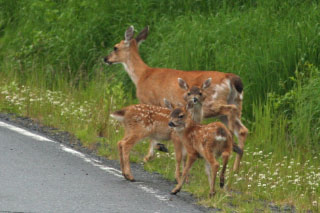 (Bert) Our trip along the coastline is relaxingly slow, winding around the
bays and inlets, surveying the luxuriant countryside and stopping occasionally
to look at wildlife. At Kalsin Bay we see both Tufted and Horned puffins and a
pair of Belted Kingfishers. The delta of Olds River is prime habitat and we
study a juvenile sparrow for several minutes before deciding it is a
Golden-crowned Sparrow. In a large cottonwood we find a pair of Black-capped
Chickadees. Introduced Bison roam the grasslands bordering Lake LaRose Tead and
nearby we see a doe and two fawns along the road. Small and chubbier, they donít
look like any deer Iíve seen before. A bit farther on we see another threesome
of the Sitka Deer as well as a Red Fox, silver form.
(Bert) Our trip along the coastline is relaxingly slow, winding around the
bays and inlets, surveying the luxuriant countryside and stopping occasionally
to look at wildlife. At Kalsin Bay we see both Tufted and Horned puffins and a
pair of Belted Kingfishers. The delta of Olds River is prime habitat and we
study a juvenile sparrow for several minutes before deciding it is a
Golden-crowned Sparrow. In a large cottonwood we find a pair of Black-capped
Chickadees. Introduced Bison roam the grasslands bordering Lake LaRose Tead and
nearby we see a doe and two fawns along the road. Small and chubbier, they donít
look like any deer Iíve seen before. A bit farther on we see another threesome
of the Sitka Deer as well as a Red Fox, silver form.
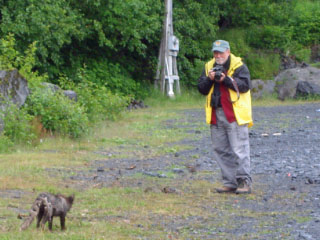
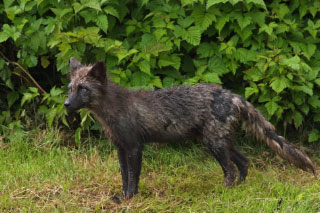 Bald Eagles gather along the drainage of Pasagshak River and from one
viewpoint I count 29. They must be watching for spawning Sockeye Salmon and
farther downstream fishermen try snagging the Reds. We stop at the only toilets
along the road, at Pasagshak State Recreation Site, and while waiting in line we
notice a Silver Fox intent on scavenging a pile of garbage carelessly left in a
corner of the building. The scrawny fox is uncommonly tame, being much more
interested in food than people. The river spills into Pasagshak Bay and here we
see a few whales blowing. When one surfaces I can see the blotchy back covered
with barnacles.
Bald Eagles gather along the drainage of Pasagshak River and from one
viewpoint I count 29. They must be watching for spawning Sockeye Salmon and
farther downstream fishermen try snagging the Reds. We stop at the only toilets
along the road, at Pasagshak State Recreation Site, and while waiting in line we
notice a Silver Fox intent on scavenging a pile of garbage carelessly left in a
corner of the building. The scrawny fox is uncommonly tame, being much more
interested in food than people. The river spills into Pasagshak Bay and here we
see a few whales blowing. When one surfaces I can see the blotchy back covered
with barnacles.
Road condition worsens, but we continue on, stopping briefly at a narrow
creek to identify a Least Sandpiper, the only shorebird we have found on the
island. At the gravel turnoff for Fossil Beach, Shari calls on the personal
radio to warn me of the road. I continue on for a half mile and then pull to the
side so that we can walk the rest of the way to the beach. Heavy fog blocks much
of the view, but we can see most of its features. Where I parked the van the
geocachers find yet another cache, this time hidden under a massive dry stump.
We eat our packed Subway sandwiches and then turn our vehicles around for the
trip back, stopping again to watch Gray Whales in the bay.
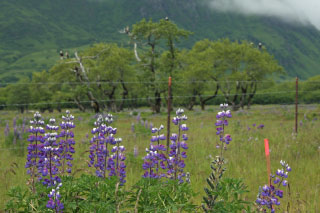 With no rush to get back soon, we pull off at Pasagshak River again and watch
the Bald Eagles. Along the river from the bay to where I stop Iíve already seen
dozens of eagles. Now, standing in one spot, I scan the area and count eagles.
On cottonwood trees, on fence lines, in the pastures, in the sky, along the
river, in the river, everywhere we see eagles and my count comes to 58 in sight
at one time.
With no rush to get back soon, we pull off at Pasagshak River again and watch
the Bald Eagles. Along the river from the bay to where I stop Iíve already seen
dozens of eagles. Now, standing in one spot, I scan the area and count eagles.
On cottonwood trees, on fence lines, in the pastures, in the sky, along the
river, in the river, everywhere we see eagles and my count comes to 58 in sight
at one time.
(Shari) We follow the paved road to its end and while the birders hike down
to Fossil Beach, Steve and I look for a cache. We find it not far from our
vehicles and log our names. After eating lunch in the vehicles, we drive back to
town. While Bert and I gas up the van and car, Donna and Jim get everyone
checked into cabins on the ferry. Steve and Nancy meet us on the dock, having
been watching our luggage while we did the errands, and we get keys to our
rooms. The room has two single beds, one above the other, a sink, a bench and a
4-ft. aisle: small, yet adequate even if the bathrooms are down the hall and to
the right. As soon as we deposit our luggage in the room, we head for the dining
room.
(Bert) A couple hours later I am dropping luggage and people off at the ferry
dock and then Shari and I refuel the vehicles and return them to the rental
agency. Since the ferry does not leave until 6 PM we all have sleeping cabins. I
dump my luggage in the cabin and we head to the cafeteria for dinner, which I
wolf down quickly so that I can be on deck to watch for whales and seabirds.
They are best when we pass through Narrow Strait and I see five Fin Whales
spouting and also three Humpback Whales. We know the Fin Whales by the shape of
the water spout: taller and narrower than the Humpback Whales. And, we can see
their long flat backs. Passing by one island with steep rock cliffs we see a
Black-legged Kittiwake colony which presumably supports 150,000 birds. At 4 mi.
distance I can see none, but by the time we get to a mile away I can see 1000+
in flight.
The ship stops at Port Lions to drop off a few cars and a dilapidated Hertz
truck that probably will be parked and never moved again. At the dock we search
diligently for the few Aleutian Terns that presumably nest here. We find three
Arctic Terns instead. Back at sea again we are in continuous view of birds and
islands.
(Shari) After dinner, I am so tired I can hardly keep my eyes open but I want
to see Port Lions and the area that has the whales. By 9 PM I have seen Port
Lions and ridden past Whale Island and can no longer stay awake for the whales.
I say goodnight to Bert, head for our room, crawl into bed and immediately fall
asleep. I am surprised that the waves of the Gulf of Alaska do not wake me. It
must be a calm sailing for except for a 2 AM bathroom break, I sleep like a
baby.
(Bert) Shari appears on deck, intent on seeing whales near Whale Island. We
pass the island without seeing whales, so at 9 PM she retreats inside. Not 20
min. later we see six to eight Fin Whales put on a water show, reminiscent of
the mechanical shows in some parks. Sometimes singly, sometimes a duet or a
trio, the spouts spray upwards and all we need is music to accompany the
choreography. With the ship traveling at 15-17 mph, the entertainment lasts 10
min. before the whales are out of sight. The skies are darkening and the islands
fewer. I announce to the others still on deck that I will quit at 10 PM unless I
see something new. At 10 I quit and so do the others. Shari is already asleep
when I return to our cabin.
Day 61 - July 15 - Kachemak Bay
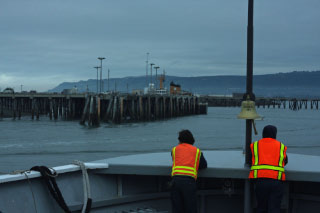 (Bert) When I step out of the room at 5:30 AM I see Chris in the hallway and
when I am on deck 15 min. later I see Bent is already up too. I recognize our
surroundings as Kachemak Bay and the seas are calm with scarcely a ripple. In my
notebook I decide to monitor the bird population, writing the time, number and
species I see. Not a minute goes by without several birds in sight. In the hour
from 5:50 to when we round the end of Homer Spit I tally: 298 Common Murres, 71
Glaucous-winged Gulls, 20 Black-legged Kittiwakes, 11 Tufted Puffins, 4
Red-necked Phalaropes, 3 Marbled Murrelets, 1 Bald Eagle and 6 Sea Otters. Most
of the birds gather in large numbers at the end of the spit and I estimate
another 400 gulls, 250 murres and 100 kittiwakes in a combined flock.
(Bert) When I step out of the room at 5:30 AM I see Chris in the hallway and
when I am on deck 15 min. later I see Bent is already up too. I recognize our
surroundings as Kachemak Bay and the seas are calm with scarcely a ripple. In my
notebook I decide to monitor the bird population, writing the time, number and
species I see. Not a minute goes by without several birds in sight. In the hour
from 5:50 to when we round the end of Homer Spit I tally: 298 Common Murres, 71
Glaucous-winged Gulls, 20 Black-legged Kittiwakes, 11 Tufted Puffins, 4
Red-necked Phalaropes, 3 Marbled Murrelets, 1 Bald Eagle and 6 Sea Otters. Most
of the birds gather in large numbers at the end of the spit and I estimate
another 400 gulls, 250 murres and 100 kittiwakes in a combined flock.
By 7 AM we are secured at the dock and disembark. Before leaving in our cars,
hugs pass around and we express well wishes for our summer break, planning on
seeing one another again in three weeks. Shari and I aim R-Tent-III northward on
the Kenai Peninsula, intending to head to the Skilak Lake area, but when Shari
hears the reds are running on the Kenai and Kasilof rivers we camp instead in
Soldotna.
 Next
Day
Next
Day  Table
of Contents
Table
of Contents
 As walk-ons, our group is the first to board the M/V Tustumena, an old ship
as denoted on the big brass bell at the bow with the date 1964. Built in
Wisconsin and refurbished on the West Coast, everything about the exterior feels
heavy and large and hard, softened only slightly by the thick layers of white
and black paint. Inside, the walkways are narrow, especially with both my arms
struggling with luggage. We dump all our bags on the seats of a table booth and
head outside. While we wait for cars and trucks to be loaded and lowered below
deck with a 2-vehicle elevator, we stand at the bow watching gulls on the dock.
Just below the pier, resting on a narrow shelf of support beams are Black-legged
Kittiwakes sitting on nests. At first I thought they were on eggs, but when two
of them rise slightly I see tiny fuzzy chicks beneath them. One chick is
obviously hungry and peeps persistently, pointing its tiny bill toward its
mother. The adult obliges and regurgitates a slimy mass of food between its open
mandibles and from which the chick pecks a tiny piece.
As walk-ons, our group is the first to board the M/V Tustumena, an old ship
as denoted on the big brass bell at the bow with the date 1964. Built in
Wisconsin and refurbished on the West Coast, everything about the exterior feels
heavy and large and hard, softened only slightly by the thick layers of white
and black paint. Inside, the walkways are narrow, especially with both my arms
struggling with luggage. We dump all our bags on the seats of a table booth and
head outside. While we wait for cars and trucks to be loaded and lowered below
deck with a 2-vehicle elevator, we stand at the bow watching gulls on the dock.
Just below the pier, resting on a narrow shelf of support beams are Black-legged
Kittiwakes sitting on nests. At first I thought they were on eggs, but when two
of them rise slightly I see tiny fuzzy chicks beneath them. One chick is
obviously hungry and peeps persistently, pointing its tiny bill toward its
mother. The adult obliges and regurgitates a slimy mass of food between its open
mandibles and from which the chick pecks a tiny piece. 


 (Bert) I take the co-pilots seat, although I will contribute nothing toward
the flight controls. Taking off from the water our lift-off is smooth as silk
and soon we are looking down at the seacoast from a gullís viewpoint. Throughout
the 45-min. ride our pilot Josh keeps the plane close to the ground, lifting
over the mountain tops and dropping low over the valleys, lakes and streams.
Rising over one mountain we look down to see a flock of 47 Dallís Sheep scatter
from the noise of the plane. Inside the plane it is quiet since we each wear
headsets that allow us to communicate among ourselves and the pilot. He tells us
we are headed to Frazier Lake and as we approach we can see Dog Salmon River
pouring from the lake. Josh severely tilts the wings and we look down at the
river and can see a couple of fishing Kodiak Bears midstream.
(Bert) I take the co-pilots seat, although I will contribute nothing toward
the flight controls. Taking off from the water our lift-off is smooth as silk
and soon we are looking down at the seacoast from a gullís viewpoint. Throughout
the 45-min. ride our pilot Josh keeps the plane close to the ground, lifting
over the mountain tops and dropping low over the valleys, lakes and streams.
Rising over one mountain we look down to see a flock of 47 Dallís Sheep scatter
from the noise of the plane. Inside the plane it is quiet since we each wear
headsets that allow us to communicate among ourselves and the pilot. He tells us
we are headed to Frazier Lake and as we approach we can see Dog Salmon River
pouring from the lake. Josh severely tilts the wings and we look down at the
river and can see a couple of fishing Kodiak Bears midstream.  (Bert) Our landing on Frazier Lake is so smooth we do not know we have
touched water until we look out of the side windows to see splashing runners.
The land is dry so we can remove our boots and put on our tennis shoes. We head
off along the trail through fields of Wild Geranium and Coastal Paintbrush. No
trees are in this valley except for a few shrub sized willows from which
Golden-crowned Sparrows and Wilsonís Warblers sing. I wish there were more of
the Tree Swallows overhead to capture the hundreds of insects buzzing around our
heads, fortunately not biting though. Three-quarters mile along the trail we can
see Dog Salmon River and my first glimpse of a Kodiak Bear.
(Bert) Our landing on Frazier Lake is so smooth we do not know we have
touched water until we look out of the side windows to see splashing runners.
The land is dry so we can remove our boots and put on our tennis shoes. We head
off along the trail through fields of Wild Geranium and Coastal Paintbrush. No
trees are in this valley except for a few shrub sized willows from which
Golden-crowned Sparrows and Wilsonís Warblers sing. I wish there were more of
the Tree Swallows overhead to capture the hundreds of insects buzzing around our
heads, fortunately not biting though. Three-quarters mile along the trail we can
see Dog Salmon River and my first glimpse of a Kodiak Bear. 


 (Bert) Our trip along the coastline is relaxingly slow, winding around the
bays and inlets, surveying the luxuriant countryside and stopping occasionally
to look at wildlife. At Kalsin Bay we see both Tufted and Horned puffins and a
pair of Belted Kingfishers. The delta of Olds River is prime habitat and we
study a juvenile sparrow for several minutes before deciding it is a
Golden-crowned Sparrow. In a large cottonwood we find a pair of Black-capped
Chickadees. Introduced Bison roam the grasslands bordering Lake LaRose Tead and
nearby we see a doe and two fawns along the road. Small and chubbier, they donít
look like any deer Iíve seen before. A bit farther on we see another threesome
of the Sitka Deer as well as a Red Fox, silver form.
(Bert) Our trip along the coastline is relaxingly slow, winding around the
bays and inlets, surveying the luxuriant countryside and stopping occasionally
to look at wildlife. At Kalsin Bay we see both Tufted and Horned puffins and a
pair of Belted Kingfishers. The delta of Olds River is prime habitat and we
study a juvenile sparrow for several minutes before deciding it is a
Golden-crowned Sparrow. In a large cottonwood we find a pair of Black-capped
Chickadees. Introduced Bison roam the grasslands bordering Lake LaRose Tead and
nearby we see a doe and two fawns along the road. Small and chubbier, they donít
look like any deer Iíve seen before. A bit farther on we see another threesome
of the Sitka Deer as well as a Red Fox, silver form. 
 Bald Eagles gather along the drainage of Pasagshak River and from one
viewpoint I count 29. They must be watching for spawning Sockeye Salmon and
farther downstream fishermen try snagging the Reds. We stop at the only toilets
along the road, at Pasagshak State Recreation Site, and while waiting in line we
notice a Silver Fox intent on scavenging a pile of garbage carelessly left in a
corner of the building. The scrawny fox is uncommonly tame, being much more
interested in food than people. The river spills into Pasagshak Bay and here we
see a few whales blowing. When one surfaces I can see the blotchy back covered
with barnacles.
Bald Eagles gather along the drainage of Pasagshak River and from one
viewpoint I count 29. They must be watching for spawning Sockeye Salmon and
farther downstream fishermen try snagging the Reds. We stop at the only toilets
along the road, at Pasagshak State Recreation Site, and while waiting in line we
notice a Silver Fox intent on scavenging a pile of garbage carelessly left in a
corner of the building. The scrawny fox is uncommonly tame, being much more
interested in food than people. The river spills into Pasagshak Bay and here we
see a few whales blowing. When one surfaces I can see the blotchy back covered
with barnacles.  With no rush to get back soon, we pull off at Pasagshak River again and watch
the Bald Eagles. Along the river from the bay to where I stop Iíve already seen
dozens of eagles. Now, standing in one spot, I scan the area and count eagles.
On cottonwood trees, on fence lines, in the pastures, in the sky, along the
river, in the river, everywhere we see eagles and my count comes to 58 in sight
at one time.
With no rush to get back soon, we pull off at Pasagshak River again and watch
the Bald Eagles. Along the river from the bay to where I stop Iíve already seen
dozens of eagles. Now, standing in one spot, I scan the area and count eagles.
On cottonwood trees, on fence lines, in the pastures, in the sky, along the
river, in the river, everywhere we see eagles and my count comes to 58 in sight
at one time.  (Bert) When I step out of the room at 5:30 AM I see Chris in the hallway and
when I am on deck 15 min. later I see Bent is already up too. I recognize our
surroundings as Kachemak Bay and the seas are calm with scarcely a ripple. In my
notebook I decide to monitor the bird population, writing the time, number and
species I see. Not a minute goes by without several birds in sight. In the hour
from 5:50 to when we round the end of Homer Spit I tally: 298 Common Murres, 71
Glaucous-winged Gulls, 20 Black-legged Kittiwakes, 11 Tufted Puffins, 4
Red-necked Phalaropes, 3 Marbled Murrelets, 1 Bald Eagle and 6 Sea Otters. Most
of the birds gather in large numbers at the end of the spit and I estimate
another 400 gulls, 250 murres and 100 kittiwakes in a combined flock.
(Bert) When I step out of the room at 5:30 AM I see Chris in the hallway and
when I am on deck 15 min. later I see Bent is already up too. I recognize our
surroundings as Kachemak Bay and the seas are calm with scarcely a ripple. In my
notebook I decide to monitor the bird population, writing the time, number and
species I see. Not a minute goes by without several birds in sight. In the hour
from 5:50 to when we round the end of Homer Spit I tally: 298 Common Murres, 71
Glaucous-winged Gulls, 20 Black-legged Kittiwakes, 11 Tufted Puffins, 4
Red-necked Phalaropes, 3 Marbled Murrelets, 1 Bald Eagle and 6 Sea Otters. Most
of the birds gather in large numbers at the end of the spit and I estimate
another 400 gulls, 250 murres and 100 kittiwakes in a combined flock.